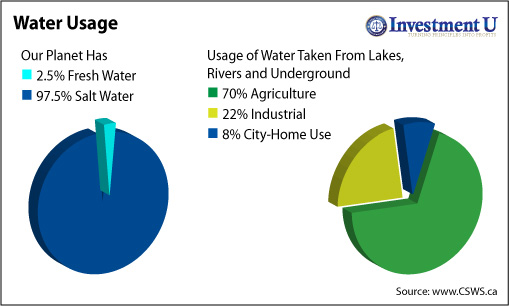Article by Investment U

You can be a contrarian. Or you can be a victim. If you prefer the former, here are a few simple ways to invest in water.
“You can be a contrarian. Or you can be a victim.”
– Rick Rule
As Executive Editor of Investment U, I’m dedicated to providing you with the most sound investment philosophies and unique contrarian investment ideas on a daily basis.
And as our Chief Investment Strategist Alexander Green wrote earlier this year, our newsletter’s aim is to provide you with “the best investment you can make in four minutes each day.”
In that light, I made some time to sit down with legendary resource expert Rick Rule at our 14th Annual Investment U Conference two weeks ago. Rick is the Chairman and CEO of Global Resource Investments LTD – part of the Sprott Group of Companies.
Rick is known to be a fierce contrarian. So of course I was curious – as I’m sure many of you are – what he sees as the most contrarian investment right now.
His answer may surprise you…
“The most obvious contrarian investment that I see isn’t one that people are pessimistic on, it’s one that people ignore totally,” Rule said. “It requires patience, but that commodity – the most underpriced commodity that I see in the spectrum – is water.”
And Rick isn’t the only one who sees water as an intriguing opportunity right now. Our own emerging markets expert Carl Delfeld recently told Oxford Club members:
“During the last century, oil was at the heart of the global economy. Nearly every development in the financial news was somehow linked to its price and availability. But in the twenty-first century, I believe the price and supply of water will dominate the headlines.”
Carl also cites a World Bank estimate that global water demand will actually double every 20 years.

Who else is making a big bet on water? None other than T. Boone Pickens…
As Carl alluded to in his recent article in The Oxford Club’s Communiqué, Pickens – through a company he controls called Mesa Water L.P. – is the largest individual water owner in America.
So what’s so impressive about water?
Politics, Politics, Politics…
In his article, Carl mentions that governments heavily subsidize water prices and like to keep tight control over water supplies.
Hmm… Governments meddling in free markets? Who would have thunk it?
Rick, who’s based out of California, is especially knowledgeable about the situation in his own state.
“[Water is] delivered politically, which means the market doesn’t work. Which means ultimately the supply won’t work because it’s mismatched with demand. In California, we use water for such ‘intelligent’ things as growing rice in the desert and producing subsidized alfalfa.
“[Meanwhile] the highest and best use in the state of California is flushing toilets and brushing teeth. And yet we supply water to some farmers in California for prices in the range of $55-$60 an acre foot and we charge urban users $1600 per acre foot. But the delta between $50/acre foot and $1500/acre foot is a very, very, very interesting arbitrage – which is effectively political.
“People who have watched the movie ‘Chinatown’ understand something about the genesis of this politics. The takeover by the city of Los Angeles – fair and square by the way, purchasing it in the market – of the water in the Ojai Valley, united the agricultural community against urban users in the 1890s and 1900s. At that point in time, the state’s economy was predominantly agricultural and the political power base in the state was rural rather than urban.”
The result, according to Rick, is 85% of the state’s water resources being used to create 3% of the state’s GDP. An interesting market anomaly indeed…
But considering most investors don’t have the financial resources or the logistical ability to invest in actual water rights, how can average investors cash in on this arbitrage?
How to Invest in Water
“The simplest way to invest in water is to invest in water,” Rule said. “The most leveraged ways might involve the technologies. But that involves being right or not being right about selecting among the best technologies. What I prefer to do is either own water rights or own companies that own water rights. I prefer for my own investing portfolio to treat water itself as a resource.”
Rick also provides a few guidelines of what potential water investors should be looking for:
- Scarcity and Locality –“Water is very local because its heavy, it costs a lot to transport. When making a water investment, one must invest in water at a place where it’s scarce. There’s no particular point in owning a bunch of water in Northern British Columbia where your challenge is to make it go away.”
- Affordability –“The second thing it has to be, is in a place where it’s not only scarce, but where the market can afford to buy it. Unfortunately, owning water in Ethiopia or Eretria where the people can’t buy it, although they need it, doesn’t yield any economic return. So it has to be scarce and it has to be rich.”
- A Sense of the Politics – “And the third thing is that water has traditionally been allocated politically. So you have to have some sense that there is going to be the rule of law and that there is, eventually, going to be a rational social response to the political idiocy of allocating water to votes rather than the market.”
Illustrative Examples
Rick is prohibited by regulation to make specific recommendations, but he did tell us that the most opportunistic regions were places like the U.S. Southwest, Southern Australia, Italy, Greece and Spain.
He also provided a few illustrative examples (not recommendations, mind you) of the types of companies that offer a play on water rights. Here are a couple:
- J.G. Boswell (OTC: BWEL.PK) – Although it’s traded over the counter, it’s a 110-yr old company. It’s also the largest cotton farmer in the world and the largest tomato farmer in the world. It owns 2,000 acres of farmland and effectively 200,000 acres of pertinent water rights. Right now, the water is used to grow cotton and tomatoes…
- Limoneira (Nasdaq: LMNR) – The second example of a water rights company masquerading as a farming company is Limoneira. It’s the largest independent lemon producer and one of the largest avocado producers. According to Rick, they control the some of the most important undeveloped water rights in Ventura County.
- Pico Holdings (Nasdaq: PICO) – Pico is an acronym for Physicians Insurance Company of Ohio. Pico is a group of financial operators who took over insurance companies and have invested the float in a series of accretive transactions. Pico was the largest water rights owner in Arizona at one time and is currently the largest water rights owner in the state of Nevada.
There are also numerous mutual funds and ETFs that offer potent exposure to water rights and water technologies. So while “the herd” is loading into toxic bond funds and precious metals, investing in water as a resource may very well be the proverbial elephant in the room for well-educated contrarians like ourselves.
Good Investing,
Justin Dove
P.S. Rick clued me into an incredible – and better yet, totally free – resource for investors who want to learn more about the energy and resource industries. You’ll definitely want to bookmark this page…
To check out Sprott Global’s free Investment University lecture library along with other helpful resources, click here.
Article by Investment U